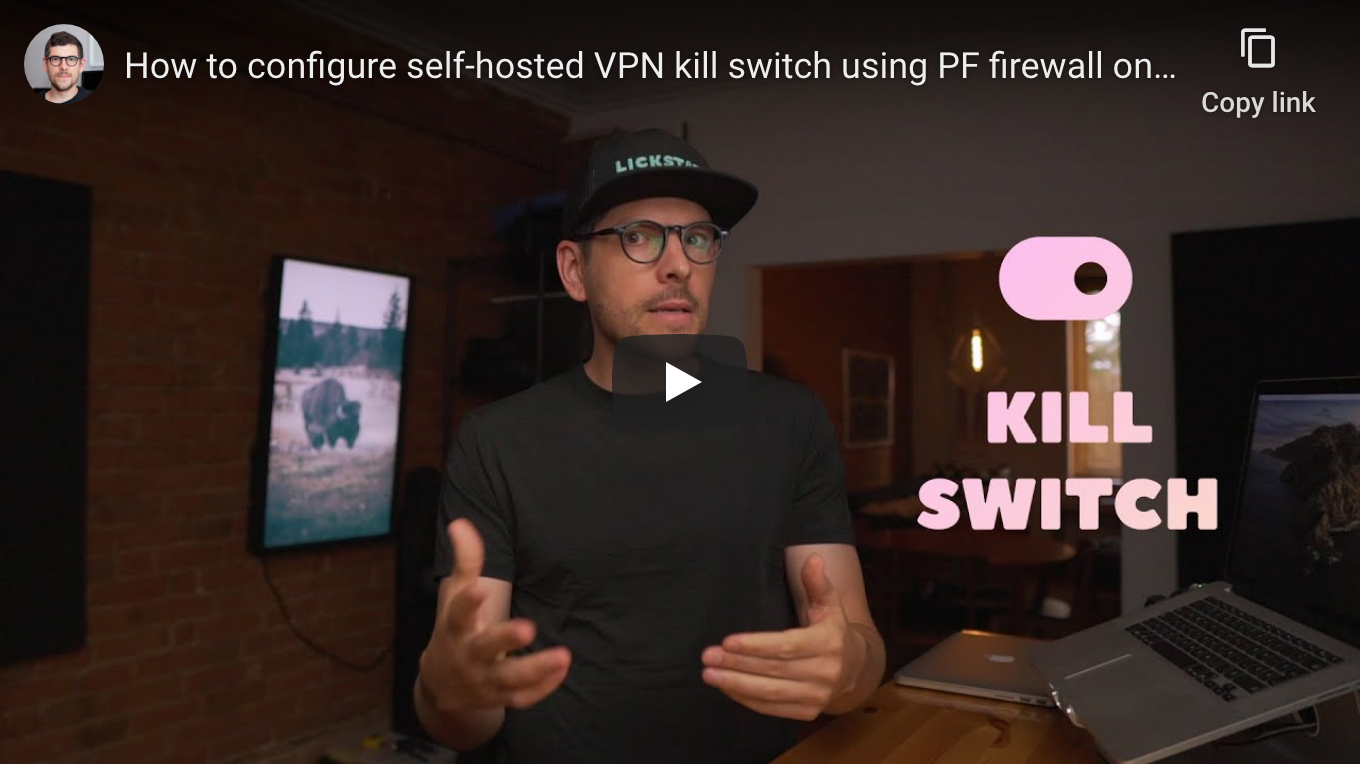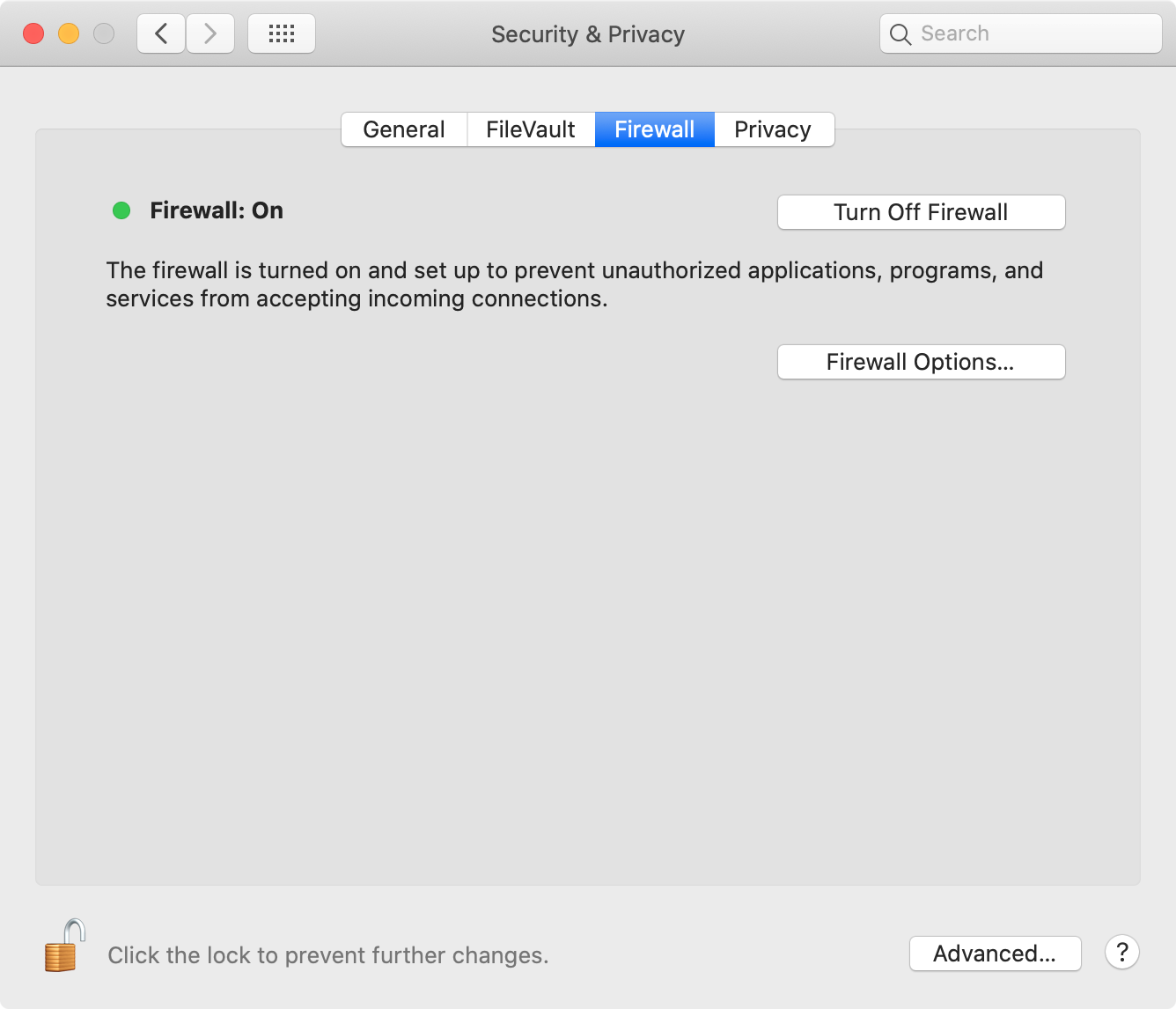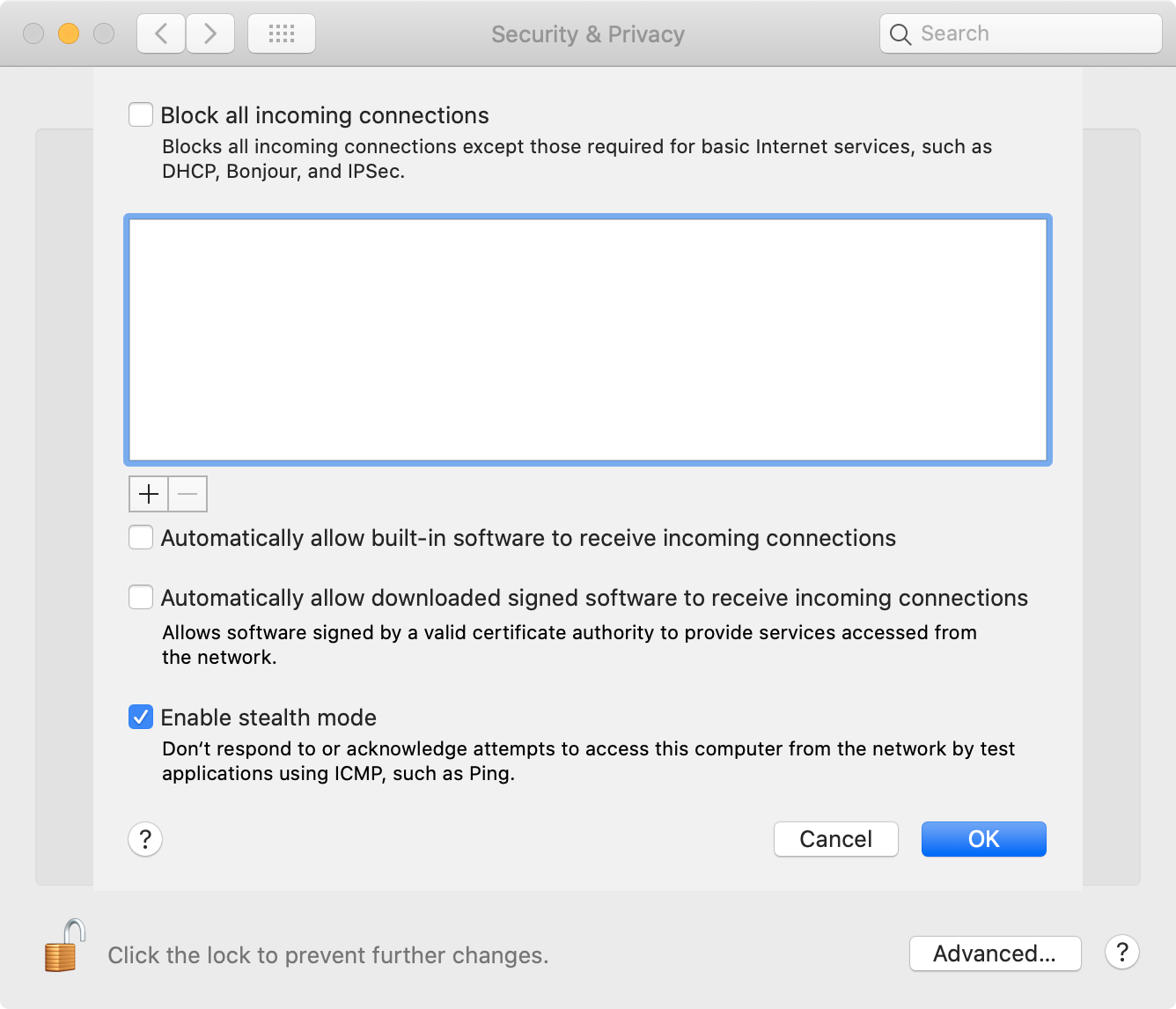| .. | ||
| firewall-options.png | ||
| firewall.png | ||
| how-to-configure-self-hosted-vpn-kill-switch-using-pf-firewall-on-macos.png | ||
| README.md | ||
How to configure self-hosted VPN kill switch using PF firewall on macOS
Heads up: when following this guide, IKEv2/IPsec VPNs will likely be unresponsive for about 60 seconds at boot and wake. Not sure what causes this issue. Please submit a PR if you know how to fix it!
Requirements
- Self-hosted virtual private network (VPN) with public IPv4 address
- Computer running macOS Mojave or Catalina
Caveats
- When copy/pasting commands that start with
$, strip out$as this character is not part of the command - When copy/pasting commands that start with
cat << "EOF", select all lines at once (fromcat << "EOF"toEOFinclusively) as they are part of the same (single) command
Guide
Step 1: enable PF
Open "System Preferences", click "Security & Privacy", then "Firewall" and enable "Turn On Firewall".
Then, click "Firewall Options...", disable all options except "Enable stealth mode".
Step 2: confirm PF is enabled
$ sudo pfctl -s info | grep "Status"
No ALTQ support in kernel
ALTQ related functions disabled
Status: Enabled for 0 days 13:02:35 Debug: Urgent
Status: Enabled
👍
Step 3: backup and override /etc/pf.conf
Heads up: software updates will likely restore
/etc/pf.confto default. Remember to check/etc/pf.confusingcat /etc/pf.confafter updates and test kill switch.
sudo cp /etc/pf.conf /etc/pf.conf.backup
cat << "EOF" | sudo tee /etc/pf.conf
anchor "local.pf"
load anchor local.pf from "/etc/pf.anchors/local.pf"
EOF
Step 4: list hardware network interfaces
$ networksetup -listallhardwareports
Hardware Port: Wi-Fi
Device: en0
Ethernet Address: Redacted
Hardware Port: Thunderbolt 1
Device: en1
Ethernet Address: Redacted
Hardware Port: Thunderbolt 2
Device: en2
Ethernet Address: Redacted
Hardware Port: Bluetooth PAN
Device: en3
Ethernet Address: Redacted
Hardware Port: iPhone USB
Device: en4
Ethernet Address: Redacted
Hardware Port: Thunderbolt Ethernet
Device: en5
Ethernet Address: Redacted
Hardware Port: Thunderbolt Bridge
Device: bridge0
Ethernet Address: Redacted
VLAN Configurations
===================
Step 4: find hardware network interface subnet prefix (example bellow is for Wi-Fi interface)
$ networksetup -getinfo "Wi-Fi"
DHCP Configuration
IP address: 10.0.1.140
Subnet mask: 255.255.255.0
Router: 10.0.1.1
Client ID:
IPv6: Off
Wi-Fi ID: Redacted
Use following table to find bitmask using subnet mask.
For example, if subnet mask is 255.255.255.0, bitmask is /24 and subnet prefix is 10.0.1.0/24.
| Subnet mask | Bitmask |
|---|---|
| 0.0.0.0 | /0 |
| 128.0.0.0 | /1 |
| 192.0.0.0 | /2 |
| 224.0.0.0 | /3 |
| 240.0.0.0 | /4 |
| 248.0.0.0 | /5 |
| 252.0.0.0 | /6 |
| 254.0.0.0 | /7 |
| 255.0.0.0 | /8 |
| 255.128.0.0 | /9 |
| 255.192.0.0 | /10 |
| 255.224.0.0 | /11 |
| 255.240.0.0 | /12 |
| 255.248.0.0 | /13 |
| 255.252.0.0 | /14 |
| 255.254.0.0 | /15 |
| 255.255.0.0 | /16 |
| 255.255.128.0 | /17 |
| 255.255.192.0 | /18 |
| 255.255.224.0 | /19 |
| 255.255.240.0 | /20 |
| 255.255.248.0 | /21 |
| 255.255.252.0 | /22 |
| 255.255.254.0 | /23 |
| 255.255.255.0 | /24 |
| 255.255.255.128 | /25 |
| 255.255.255.192 | /26 |
| 255.255.255.224 | /27 |
| 255.255.255.240 | /28 |
| 255.255.255.248 | /29 |
| 255.255.255.252 | /30 |
| 255.255.255.254 | /31 |
| 255.255.255.255 | /32 |
Step 5: set temporary environment variables
KILLSWITCH_HARDWARE_INTERFACES should include all used hardware network interfaces.
KILLSWITCH_VPN_INTERFACE should be set to VPN interface (use ifconfig to find interface).
KILLSWITCH_TRUSTED_SUBNET_PREFIXES should include all trusted subnet prefixes such as a home or office subnet prefixes (if trusted).
KILLSWITCH_VPN_ENDPOINT_IPS should include all VPN endpoint IPs.
KILLSWITCH_HARDWARE_INTERFACES="{ en0, en4, en5 }"
KILLSWITCH_TRUSTED_SUBNET_PREFIXES="{ 10.0.1.0/24 }"
KILLSWITCH_VPN_INTERFACE=ipsec0
KILLSWITCH_VPN_ENDPOINT_IPS="{ 185.193.126.203 }"
Step 6: create PF strict anchor
This anchor blocks everything except DHCP and VPN requests.
cat << EOF | sudo tee /etc/pf.anchors/local.pf.strict
# Options
set block-policy drop
set ruleset-optimization basic
set skip on lo0
# Set variables
hardware_interfaces = "$KILLSWITCH_HARDWARE_INTERFACES"
vpn_endpoint_ips = "$KILLSWITCH_VPN_ENDPOINT_IPS"
vpn_interface = "$KILLSWITCH_VPN_INTERFACE"
# Block everything
block all # Use "block log all" to log blocked packets
# Allow DHCP requests (used to establish Wi-Fi connection)
pass on \$hardware_interfaces proto udp from port { 67, 68 } to port { 67, 68 } keep state
# Allow requests to VPN server (used to establish VPN connection)
pass on \$hardware_interfaces proto { tcp, udp } from any to \$vpn_endpoint_ips
# Allow all requests on VPN interface
pass on \$vpn_interface all
EOF
sudo chmod 600 /etc/pf.anchors/local.pf.strict
Step 7: create PF trusted anchor
Same as strict but allows multicast DNS and local network requests.
cat << EOF | sudo tee /etc/pf.anchors/local.pf.trusted
# Options
set block-policy drop
set ruleset-optimization basic
set skip on lo0
# Set variables
hardware_interfaces = "$KILLSWITCH_HARDWARE_INTERFACES"
trusted_subnet_prefixes = "$KILLSWITCH_TRUSTED_SUBNET_PREFIXES"
vpn_endpoint_ips = "$KILLSWITCH_VPN_ENDPOINT_IPS"
vpn_interface = "$KILLSWITCH_VPN_INTERFACE"
# Block everything
block all # Use "block log all" to log blocked packets
# Allow DHCP requests (used to establish Wi-Fi connection)
pass on \$hardware_interfaces proto udp from port { 67, 68 } to port { 67, 68 } keep state
# Allow multicast DNS requests (used to find devices using Bonjour, disable these lines when you don’t trust the network)
pass on \$hardware_interfaces from \$trusted_subnet_prefixes to 255.255.255.255 keep state
pass on \$hardware_interfaces from 255.255.255.255 to \$trusted_subnet_prefixes keep state
pass on \$hardware_interfaces proto udp from \$trusted_subnet_prefixes port 5353 to 224.0.0.251 port 5353 keep state
pass on \$hardware_interfaces proto udp from 224.0.0.251 port 5353 to \$trusted_subnet_prefixes port 5353 keep state
# Allow local network requests (used to access local network, disable this line when you don’t trust the network)
pass on \$hardware_interfaces proto { tcp, udp } from \$trusted_subnet_prefixes to \$trusted_subnet_prefixes
# Allow requests to VPN server (used to establish VPN connection)
pass on \$hardware_interfaces proto { tcp, udp } from any to \$vpn_endpoint_ips
# Allow all requests on VPN interface
pass on \$vpn_interface all
EOF
sudo chmod 600 /etc/pf.anchors/local.pf.trusted
Step 8: create /etc/pf.anchors/local.pf symlink
sudo ln -s /etc/pf.anchors/local.pf.strict /etc/pf.anchors/local.pf
Step 9: restart PF
sudo pfctl -F all -f /etc/pf.conf
Step 10: create /usr/local/sbin folder
sudo mkdir -p /usr/local/sbin
sudo chown $(whoami):admin /usr/local/sbin/
Step 11: source /usr/local/sbin folder
Find which shell is configured using echo $SHELL.
Bash (/bin/bash)
cat << "EOF" >> ~/.bash_profile
export PATH=${PATH}:/usr/local/sbin
EOF
source ~/.bash_profile
Z Shell (/bin/zsh)
cat << "EOF" >> ~/.zshrc
export PATH=${PATH}:/usr/local/sbin
EOF
source ~/.zshrc
Step 12: create /usr/local/sbin/strict.sh convenience script
Use socketfilterfw to block specific apps.
cat << "EOF" > /usr/local/sbin/strict.sh
#! /bin/sh
if [ "$(id -u)" != "0" ]; then
echo "This script must run as root"
exit 1
fi
green=$'\e[1;32m'
end=$'\e[0m'
# /usr/libexec/ApplicationFirewall/socketfilterfw --blockapp /Applications/1Password\ 7.app
# /usr/libexec/ApplicationFirewall/socketfilterfw --blockapp /usr/local/Cellar/squid/4.8/sbin/squid
# printf "\n"
ln -sfn /etc/pf.anchors/local.pf.strict /etc/pf.anchors/local.pf
pfctl -e
printf "\n"
pfctl -F all -f /etc/pf.conf
printf "\n%s" "${green}Strict mode enabled${end}"
EOF
chmod +x /usr/local/sbin/strict.sh
Step 13: create /usr/local/sbin/trusted.sh convenience script
Use socketfilterfw to unblock specific apps (useful to allow 1Password’s local sync or Squid proxy for example).
cat << "EOF" > /usr/local/sbin/trusted.sh
#! /bin/sh
if [ "$(id -u)" != "0" ]; then
echo "This script must run as root"
exit 1
fi
red=$'\e[1;31m'
end=$'\e[0m'
function disable()
{
/usr/local/sbin/strict.sh
exit 0
}
trap disable EXIT
# /usr/libexec/ApplicationFirewall/socketfilterfw --unblockapp /Applications/1Password\ 7.app
# /usr/libexec/ApplicationFirewall/socketfilterfw --unblockapp /usr/local/Cellar/squid/4.8/sbin/squid
# printf "\n"
ln -sfn /etc/pf.anchors/local.pf.trusted /etc/pf.anchors/local.pf
pfctl -e
printf "\n"
pfctl -F all -f /etc/pf.conf
printf "\n%s\n\n" "${red}Trusted mode enabled (press ctrl+c to disable)${end}"
while :
do
sleep 60
done
EOF
chmod +x /usr/local/sbin/trusted.sh
Step 14: create /usr/local/sbin/disabled.sh convenience script
cat << "EOF" > /usr/local/sbin/disabled.sh
#! /bin/sh
if [ "$(id -u)" != "0" ]; then
echo "This script must run as root"
exit 1
fi
red=$'\e[1;31m'
end=$'\e[0m'
function disable()
{
/usr/local/sbin/strict.sh
exit 0
}
trap disable EXIT
pfctl -d
printf "\n%s\n\n" "${red}Firewall disabled (press ctrl+c to enable)${end}"
while :
do
sleep 60
done
EOF
chmod +x /usr/local/sbin/disabled.sh
Step 15: test convenience scripts
$ sudo strict.sh
Password:
No ALTQ support in kernel
ALTQ related functions disabled
pfctl: pf already enabled
pfctl: Use of -f option, could result in flushing of rules
present in the main ruleset added by the system at startup.
See /etc/pf.conf for further details.
No ALTQ support in kernel
ALTQ related functions disabled
rules cleared
nat cleared
dummynet cleared
0 tables deleted.
64 states cleared
source tracking entries cleared
pf: statistics cleared
pf: interface flags reset
Strict mode enabled
$ sudo trusted.sh
No ALTQ support in kernel
ALTQ related functions disabled
pfctl: pf already enabled
pfctl: Use of -f option, could result in flushing of rules
present in the main ruleset added by the system at startup.
See /etc/pf.conf for further details.
No ALTQ support in kernel
ALTQ related functions disabled
rules cleared
nat cleared
dummynet cleared
0 tables deleted.
6 states cleared
source tracking entries cleared
pf: statistics cleared
pf: interface flags reset
Trusted mode enabled (press ctrl+c to disable)
$ sudo disabled.sh
No ALTQ support in kernel
ALTQ related functions disabled
pf disabled
Firewall disabled (press ctrl+c to enable)
Step 16: make sure PF is set to strict at boot
cat << EOF | sudo tee /Library/LaunchDaemons/local.pf.plist
<?xml version="1.0" encoding="UTF-8"?>
<!DOCTYPE plist PUBLIC "-//Apple//DTD PLIST 1.0//EN" "http://www.apple.com/DTDs/PropertyList-1.0.dtd">
<plist version="1.0">
<dict>
<key>Label</key>
<string>pf</string>
<key>ProgramArguments</key>
<array>
<string>/usr/local/sbin/strict.sh</string>
</array>
<key>RunAtLoad</key>
<true/>
</dict>
</plist>
EOF
Want things back the way they were before following this guide? No problem!
Step 1: restore /etc/pf.conf from backup
sudo cp /etc/pf.conf.backup /etc/pf.conf
Step 2: delete anchors, convenience scripts and launch daemon
Delete anchors
sudo rm /etc/pf.anchors/local.pf
sudo rm /etc/pf.anchors/local.pf.strict
sudo rm /etc/pf.anchors/local.pf.trusted
Delete convenience scripts
rm /usr/local/sbin/strict.sh
rm /usr/local/sbin/trusted.sh
rm /usr/local/sbin/disabled.sh
Delete launch daemon
sudo rm /Library/LaunchDaemons/local.pf.plist
Step 3: restart PF
sudo pfctl -F all -f /etc/pf.conf


